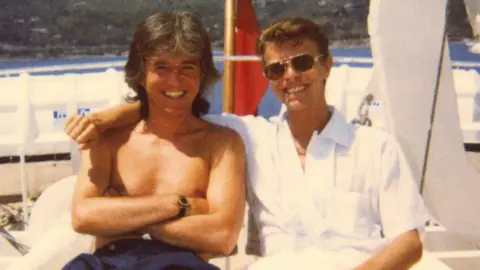 George Underwood
George UnderwoodThe artist George Underwood is taking part in a charity exhibition that was inspired by a lyric written by his school friend and creative collaborator David Bowie – but it is a particular episode in the late music legend’s life for which he will always be most famous.
“I know what you’re going to say. I know exactly what you’re going to say,” Underwood laughs over the phone.
The 77-year-old has enjoyed an extremely successful career, creating images that are recognised around the world, but he is still known best as the man who “changed the colour” of Bowie’s left eye.
Underwood first met David Robert Jones – who would become better known as David Bowie – not long after the future star had moved from Brixton in south London to the quiet suburb of Bromley.
 Getty Images
Getty Images“We met when we were enrolling for the Cubs. We were nine years old and started talking about music, stuff that was on the telly… everything that was sort of fashionable at that time.”
The pair were soon best pals who “were always being silly and laughing a lot”, says Underwood.
“We were always together, we were very good friends and we used to go up and down Bromley High Street all dressed to the nines, thinking we were God’s gift, trying to chat up all the girls, walking from the north Wimpy bar to the south Wimpy bar.”
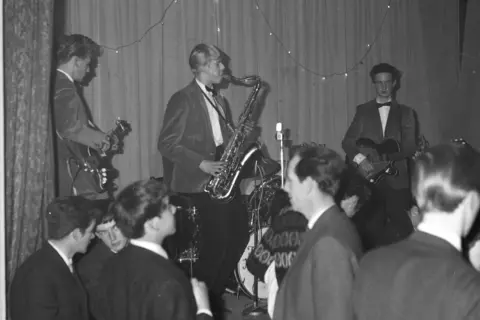 Getty Images
Getty ImagesThey both attended Bromley Technical College, which was so new “some of the builders’ stuff was still lying around in the entrance”, where they were taught art by Owen Frampton, father of future rock star Peter Frampton.
It was at Bromley Technical – now called Ravens Wood School – that Underwood forever changed the look of David Bowie, following a row about a girl called Carol to whom they had both taken a liking.
After the pair’s attempts to woo her had failed at a chaotic 15th birthday party, where “a whole troop of blokes came in carrying bottles of gin”, Underwood agreed to meet Carol at a youth club the next evening, only for Bowie to tell him she had decided to go out with him instead.
“I decided to go down the youth club anyway a little bit later on because I’d never been there before and her mate came out shouting: ‘Where have you been? Carol’s been waiting for you for over an hour.’
“I thought: ‘Uh-oh. David’s told me a porky pie here,'” Underwood says.
Having been egged on by another friend “to stick one on him”, and hearing Bowie falsely boasting he had been out with Carol, during break time at school Underwood “went over to him and just whacked him in the eye”.
The pair made up soon afterwards even though the punch had permanently damaged the pupil in Bowie’s left eye, meaning it would no longer dilate even in bright lights, giving it the impression of being a different colour from his right eye.
“It was just horrible. I didn’t like it at the time. But of course later on, lo and behold, he says I did him a favour because it’s given him this enigmatic, otherworldly look.”
 George Underwood
George UnderwoodIt was during this time that music began to take over the teenagers’ lives, with Underwood singing in the band The Konrads, which Bowie then joined and played his saxophone.
Later they formed the King Bees, when the future Starman would display his thirst for fame in a note to John Bloom, “who was I suppose at the time the equivalent to, say, Richard Branson”.
“I think he had his dad to help him with the letter but it was quite ballsy, you know: ‘Brian Epstein’s got The Beatles; you need us’, or something like that,” says Underwood.
The band received a telegram in reply providing the phone number for Leslie Conn, who became their manager.
“The springboard that David made, by writing that letter, into the lower ladder of rock’n’roll and music – it was amazing.”
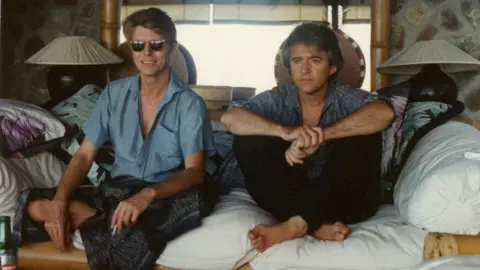 George Underwood
George Underwood The King Bees would soon split up but in various guises Bowie began to build up a following. Within a few years he was off on his own world tours – and was keen to have his friend along for the ride.
“In early ’72 he rang me and said: ‘Hey George, I’m doing a tour of the States for about three months. Do you wanna come with me?’ I’d only been married for about a year but he said: ‘Oh bring the wife, you know, we’ll have a great time.’
“Well you don’t turn that down, do you? Especially when he says: ‘The QE2, first class, is leaving Southampton on Saturday.’”
It was in 1972 that Bowie first adopted his most famous alter ego, Ziggy Stardust, complete with flared jumpsuits and sparkling leotards.
“Seeing the audiences looking at this creature from another planet, their mouths wide open, they couldn’t believe it,” says Underwood.
“When you think about it, how brave he was to dress up like he did, going to some of these places which were pretty rough areas. One place was actually cancelled in Texas because I think there were some threats.”
Come the end of the tour, Bowie asked his friend to join him for more shows in Japan, only for Underwood, with a heavy heart, to tell him: “David, I’ve just got married, it’s not a very good basis for a marriage going on a rock’n’roll tour.
“I’d have loved to go to Japan, but I had a life at home,” he says.
 Getty Images
Getty ImagesUnderwood’s own forays into music ended after one solo album, when he decided “the music business wasn’t really for me” and he returned to his art studies and became a painter.
But he wouldn’t leave the music industry far behind.
“David rang me one day and said: ‘George, I’ve got this mate of mine, he’s just done a record and he’s looking for someone to do the cover and I thought you’d be good for it.'”
That mate was Marc Bolan, and Underwood soon found himself sitting in a South Kensington flat with producer Tony Visconti while the T-Rex star “was sitting cross-legged on the floor staring at his girlfriend at the time for about 10 minutes”.
With an idea in his head, Underwood returned to his parents’ house, where he was living at the time, and created what became the cover for the rather wordy debut album of Bolan’s Tyrannosaurus Rex – My People Were Fair and Had Sky in Their Hair… But Now They’re Content to Wear Stars on Their Brows.
Bowie then asked his friend to create some of the artwork for his own albums, starting with the back of the star’s self-titled record. Next came the front covers of both Hunky Dory and The Rise and Fall of Ziggy Stardust and the Spiders from Mars – the latter famously depicting Bowie’s alien alter ego in a rainy Heddon Street in London’s West End, leg propped up and guitar in hand.
“Who was to know how such an iconic album it was gonna be? I mean, in those days, David wasn’t very well known,” Underwood says.
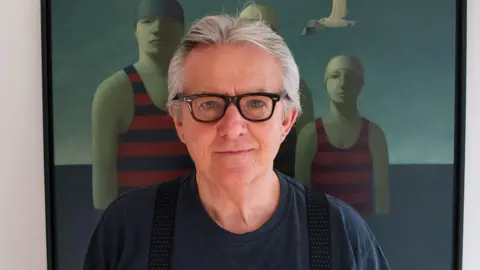 George Underwood
George UnderwoodUnderwood would go on to work with groups including Procol Harum and Mott the Hoople and also forged a painting career away from music, but it is art linked to Bowie that features in one of Underwood’s latest works.
Coinciding with the 50th anniversary of the release of Bowie’s album Diamond Dogs, charity War Child has launched Sound & Vision – a new annual exhibition and auction. This year, Underwood is among 33 artists who have created pieces inspired by the lyric from the track Rebel Rebel, “We like dancing and we look divine”, a song that featured on the Diamond Dogs album.
Underwood has created a new version of a painting called Dancing with Giants, featuring two dancers who have been dressed in very specific clothing.
“I put them in the costumes that the dancers were wearing when Ziggy arrived in 1972 at the Rainbow [Theatre],” Underwood explains.
Bowie’s show in August that year, as Ziggy Stardust, featured a dance group called The Astronettes who were led by one of Bowie’s key influences, Lindsay Kemp.
“They had these lovely full-body suits, which were like spider-webs. People who know will know about that Bowie connection.”
 George Underwood
George Underwood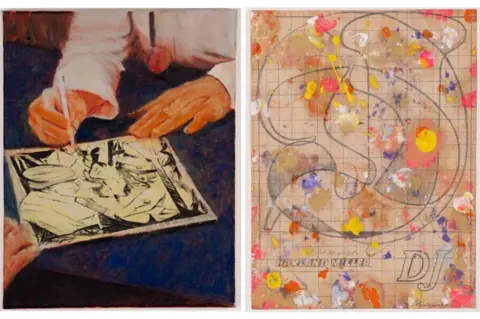
Underwood and Bowie remained friends throughout the decades, holidaying together and regularly exchanging “silly emails”, until the star’s death in his adopted home of New York in January 2016.
“He used to call me Michael and I would call him Robert,” says Underwood.
“I miss him deeply because he went too soon, as we know, and he was just great to be with, always fun to be with. We laughed a lot.
“I often wondered whether every time he looked in the mirror whether he thought of me,” Underwood adds.
“I’m just a bit worried that I might have it carved on my tombstone.”
Sound & Vision will be on show at 180 Strand on 26 and 27 September, with the auction running from 17 September to 1 October

